King James Cosmology
3b
The Golden Age of Discovery and Revelation
One can easily visualize the Dutch eyeglass makers of the last chapter goofing around with reading stones and lenses in their makeshift laboratories. One day one of then likely grabbed a lens in one hand and another lens in the other and was looking through them both and saw the same blurry sight they all had seen before, but then something different happened. The Dutchman held one close to his eye and the other farther away and happened to hit the sweet spot of convergence—the point of focus where all became clear. It was hard to hold the lenses in the precise spots needed to duplicate this "focus," but when it happened the sight was amazing; it made distant objects appear closer! Another enterprising soul made a tube to hold the lenses and block the extraneous light and they had the world's first working telescope.
In the meanwhile, Johannes Kepler was a student of Tycho Brahe and eventually replaced him as the "imperial mathematician." Here is a quote from www.faithfulscience.com,
"...After experimenting with various possible shapes for the planetary orbits, and many failed attempts, Kepler finally discovered that the observed planetary motions could be described with unprecedented precision by supposing that the planets move in elliptical orbits around the sun [instead of perfect circles]."
With Kepler's model showing the planets move in elliptical orbits he was able to precisely predict the location of the planets at any given time. Something that was not possible with the Ptolmaic model. The same year Kepler published his findings, news of the new invention now known as the "telescope" spread around the scientific community in Europe like wildfire. The Italian Galileo Galilei got wind of the new "spyglass" (it's interesting that the inventors "marketed" the device for spying on one's neighbors), and after seeing some written plans decided to make one of his own. While building his new telescope he improved the design and instead of pointing it toward his neighbors, he pointed it to the heavens. In that same year he made some observations that rocked the scientific world like few things have since creation!
One new sight he beheld was the rough and bumpy surface of the moon. Man from time immemorial (at least from Aristotle) has insisted that the moon was a perfect heavenly body with no ugly mountains or valleys to deform its pristine surface. Since it was not subject to the curse God placed on earth, it must be perfect. Galileo's telescope proved them wrong. He said he found the,
"surface of the moon to be not smooth, even and perfectly spherical,...,but on the contrary, to be uneven, rough, and crowded with depressions and bulges. And it is like the face of the earth itself, which is marked here and there with chains of mountains and depths of valleys."
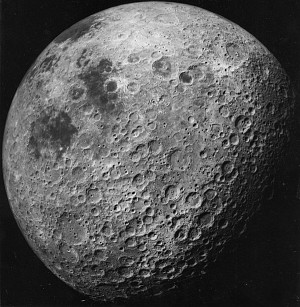
Similar to the "imperfect" moon revelation, Galileo saw "spots" on the sun. According to the Aristotelian ideal of a perfect cosmos, spots on the sun simply did not fit. How could God's perfect creation have these "imperfections"? Galileo also determined the sun was rotating.
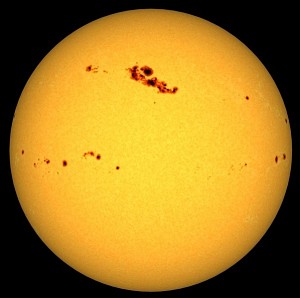
Another sight Galileo was the first to see were the moons of Jupiter. He saw four specks of light in line with the planet and they moved in relation to it every night. He inferred that these must be moons and they orbited Jupiter just like earth's moon orbits it. This also destroyed the long held Ptolemic Geocentric view that everything in the universe orbited only the earth.
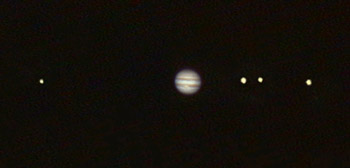
A fourth new sight was the phases of Venus. As another said,
"Venus was observed to go through a sequence of phases similar to the Moon. This could not be explained in the Ptolemaic model but could be accounted for by either the Sun-centered Copernican model or the Earth-centered Tychonic model that had the other planets orbiting the Sun as it orbited the Earth. Galileo rejected Tycho's model as an unnecessary hybrid and used the discovery to consolidate his support of the Copernican model."
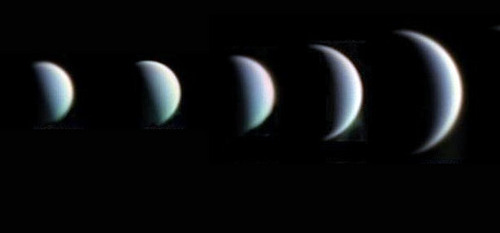
One other great revelation the Lord allowed Galileo to see was when he pointed his spyglass into the Milky Way, he saw that it was not just a huge cloudy or milky part of the sky, it was actually filled with more stars! Much too many to count. This new fact posed the question as to why there were objects in the heavens that were invisible to the natural man; invisible for millennia until this new "telescope" was invented. Why was God hiding things from His creatures?
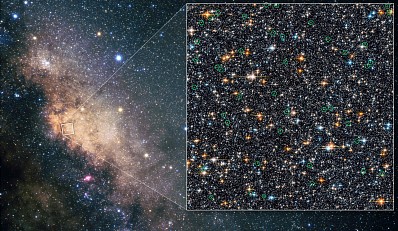
The old ways and thoughts that man had held since creation were crumbling before their eyes in 1610 when Galileo published his findings. Some claimed Galileo's telescope was "trickery" or "of the devil" and he would prove to them in daylight by letting them look at buildings and trees that the glass did not change anything, it only made distant objects appear closer. Everything in the heavens Galileo saw in 1609 anyone today can see with a good pair of binoculars or small telescope. He can now easily see heavenly details that were hidden from man since Adam.
Galileo's discoveries got him in "hot water" with the "scholarly community" and the religious establishment—the Roman Catholic Church. The Roman Catholic court system (Inquisition) ruled that Heliocentrism was heretical and ordered Galileo to abandon it. He didn't and was eventually sentenced to house arrest for the rest of his life.
A Time of Revelation
The early 17th century seems to be an extra dense time period of revelation and discovery. Consider the time line,
-
1603 - King James of England is coronated
-
1603 - King James commissions the translating of an Authorized Version of the Bible
-
1607 - English settlers looking for "New England" discover the James River in Virginia and found Jamestown.
-
1608 - The telescope is invented by Dutchman.
-
1609 - Galileo discovers several unknown revelations in the heavens
-
1609 - Kepler reveals two of his laws of planetary motion.
-
1611 - The Authorized Version of the Bible was published.
The Lord had more revelations to reveal in the 17th century, and some of the most enduring and far-reaching were those given to "a deeply introverted character" named, Isaac Newton.
The Reluctant Genius
Newton was born prematurely on Christmas Day 1642, a few months after his father died. When he was three his mother remarried, but Newton's new father did not want a stepson so he was left behind with his grandparents when his parents moved away. Little Isaac was scarred by their abandonment of him and later said he thought of burning their house down around them. He spent a lot of time in solitude pondering things.
Initially Newton was a poor student in school. The mundane courses the school taught did not much interest him. Eventually, he became a better student and entered Trinity College in Cambridge. In 1665 the dreaded Black Death once again entered London and spread fear throughout the city and all England. Cambridge University closed it doors and sent the students out of the city hoping the squelch the spread of the disease. Newton went back home and spent much of the next two years in solitude working on his experiments, mathematics, physics, and whatever else interested him.
Note: The Black Death or Bubonic Plague took a severe toll on London. It was first found near the docks and shipyards and quickly spread throughout the city. At its height it was killing more than 6000 people a week. The stench of death was everywhere. No one knew the cause. It was speculated it was carried by animals such as dogs and cats so a campaign was initiated to eradicate the city of these vermin. Every dog, cat, or other animal was killed by any means available, but it was impossible to find and kill all the rats. London was a rat infested city, they were everywhere and were pretty much considered unwelcome but permanent residents. Little did the Londonites know but the rats were in a sense the carriers of the plague, not of the disease itself but of the tiny insect that did carry it, the flea. Over an 18 month period within 1665-66 over 100,000 people died in London alone. Around one fourth the population.
While the plague raged in London, Newton was safe in his country home with plenty of time to think. While gazing out into a field near his home he saw an apple fall from a tree. Its fall raised several questions in Newton's probing mind, "Why did the apple fall?" "Why did it fall straight down and not waver to the right or left?" "Does this pull towards the earth go all the way up into the heavens?" While alone to his thoughts Newton used inductive reasoning to formulate the basis of the three laws of motion that bare his name yet today. He was 23 years old.
Newton's revelations about gravity have held true in the subsequent centuries and are the basis for all modern physics. After around 5600 years of Bible history the Lord finally allowed a man to discover some of the basic laws and principles that govern the universe He created. Arguably, these laws, more than any other discovery, are responsible for the great Industrial and Scientific Revolution that began soon after. Building upon the discoveries of Galileo, Kepler, and other "giants," Newton laws started "nailing down" the framework of just how the physical universe works. With them he was able to explain all known movements of the planets with much greater accuracy and detail than any Geocentric model, plus Newton's Heliocentrism could predict the location of unknown celestial bodies. One key proof of this is the discovery of the planet Neptune.
Newton Put to the Test
Using Newton's laws of motion and gravitational theory, astronomers found slight disturbances in the orbit of Uranus (discovered in 1781). These disturbances caused the observers to predict that there was another planet past Uranus that was affecting its orbit. In 1846 Johann Gottfried Galle discovered Neptune precisely where Newton's laws said it should be. As Robert Carter said,
"This was perhaps the greatest achievement of the Newtonian system, and ranks as one of the greatest achievements of experimental science. The perturbations of Jupiter and Saturn on Uranus are greater than that of Neptune and it was only by applying Newtonian gravitational theory to the situation (by factoring out the effects of Jupiter and Saturn) that Neptune could be discovered. What is even more amazing is that Uranus, with an orbital period of 84 years, had not even completed one orbit of the sun before it was used to find Neptune!"
Carter continues by showing how Neptune could have never been discovered using any Geocentric model,
"Absolute geocentrism could never have predicted Uranus and Neptune from orbital mechanics. Remember, both the Ptolemaic and Tychonian models are kinematic: they merely describe how planets are observed to move. Any observed deviations are just tacked on to the model—what's another epicycle here or there? Only under a dynamic model [Newton's Heliocentric model] with forces causing motions, can a deviation from predictions have any real meaning."
Thus geocentrism can only deal with bodies as they are observed. It cannot predict anything previously unknown.
Note: At this point sly geocentrists will often claim Newton spoke of how geocentrism could be possible in his model. As "proof" they will bring up an unpublished proposition called "Proposition 43" where Newton said the Geocentric system could work if the proper forces existed to counteract the gravity of the sun, but this is a BIG IF! Of course, any contention is possible if one can conjure up the forces to cause it. All Newton was saying is geocentrism is theoretically possible IF some force unknown to him was available. geocentrists try to claim these magic forces do exist among the stars and travel through the mysterious ether to effect the sun and planets (See chapter on science). How convenient. See this page for more details
geocentrism Abandoned by Scientific Community
Since the Ptolemaic model was proven untenable by Kepler and Galileo, the Tychonic system was then embraced by some geocentrists. Since it was a hybrid, compromise system that had all the planets orbiting the sun and the sun in turn orbiting the earth, it could account for the phases of Venus and other observations which doomed the Ptolemaic model. Over the succeeding generations more and more geocentrists abandoned all models of geocentrism for the Heliocentric model until it became dominate. By the 19th century (especially when Friedrich Bessel made the first successful measurements of annual parallax for a star in 1838), Heliocentrism was the accepted system. Although the transition was slow, deliberative, and took the better part of three centuries, geocentrism as a cosmology has been essentially abandoned by the scientific community.
Of the 6000 years of recorded history, it took around 5400 of those years for most of humanity to realize the earth was round and not flat, and it took nearly 5800 years for the majority of astronomers to conclude the earth revolved around the sun instead of vice versa. The Lord kept these truths to Himself for the vast extent of human history.
The Discoveries Continue
Newton's laws unifying ideas about the motions of the stars, planets, and the earth broke the ground for many subsequent discoveries the Lord allowed to be made. Furthermore, discoveries in other areas of science were occurring as well. Michael Faraday is one of the most prominent. He was "widely regarded as the greatest experimenter of all time. His work involved showing that magnetism could produce electricity, and discovering benzene, among many other things."
James Clerk Maxwell is another great scientist. He "discovered the four fundamental equations of electricity and magnetism, and predicted electromagnetic radiation at a certain enormous speed. Light was measured to have that speed—300,000 km (186,000 miles) per second—showing that light was electromagnetic radiation.
Without the discoveries of Newton, Faraday, and Maxwell, we wouldn't have much of the knowledge and technology we have today. "Practically everything involving moving parts, electricity, and magnetism can in part be attributed to the work of these three men."
What is little reported by the scientist community today is all three men were avowed creationists and believed in the God of the Bible. As another said, "
"By today's standards [Newton, Faraday, and Maxwell] would be regarded as 'fundamentalists'. Newton wrote more on theology than he ever did on science, believing the Bible to be God's Word. Faraday was a member of a very conservative offshoot of the Church of Scotland, the Sandemanians. The Sandemanians were known for their plain interpretation of the Bible...Maxwell was widely read in theology. He interacted with many of the best theological minds of his day, always as a solid evangelical Christian."
These three men were the heroes of a soon coming scientist who unfortunately did not share in their religious convictions—Albert Einstein.
Is it Really Relative?
Einstein's theory of relativity was first proposed in 1905 and according to even creation scientists it is "the most experimentally vindicated theory of gravity in existence. It has not 'disproved' Newton's laws, but has absorbed them within a larger framework, being a more accurate description under certain conditions." Where Newton's laws show the effects of gravity without defining its source or cause, Einstein's theory actually defines it as a warp in what he calls space-time. His theory is called "relativity" because it states there is no fixed frame of reference in the physical universe. Everything is moving relative to everything else, thus there can be no such thing as an absolute center or fixed location.
This idea of relativity is another bane of geocentrism. If everything in the universe is only moving relative to something else then the whole concept of geocentrism is moot. Yes, geocentrists can truthfully say that their "coordinate system" of the universe can be a valid frame of reference according to relativity, but since all motion is relative any "coordinate system" can be valid. Once could just as accurately say the sun, moon, a house, or a person's big toe is the center of the universe and everything else revolves around it. geocentrism looses all its uniqueness with relativity so its adherents deny the whole idea...but only to a point.
Although geocentrists vociferously reject general relativity, they often appeal to its concepts to defend geocentrism when pressed. For example, when someone challenges the geocentrists contention that the universe is spinning around the earth and reminds them that from near the orbit of Neptune and beyond it must be moving faster than the speed of light, the Geocentric will reply that the motion is relative to the earth, not between the distant stars. That is, they claim the universe is one huge spinning object and the stars are not moving within that object so they are not moving relative to each other. Thus they appeal to relative motion to support a claim while at the same time insisting they deny relativity. Typical inconsistent behavior. For more details on the geocentrists blatant inconsistency see this page and this one.
The Increasing Rate of Revelation
Daniel 12:4 is an oft quoted passage when discussing end-time events and prophecies,
"But thou, O Daniel, shut up the words, and seal the book, even to the time of the end: many shall run to and fro, and knowledge shall be increased."
The context is the prophecies the Lord had just given to Daniel. He speaks of how the words will be sealed to the time of the end when many will run "to and fro" and "knowledge will be increased." Some of the old commentators claim the increase in knowledge refers to the revelation of the words of the prophecies, and certainly that has application. But the verse also seems to indicate that the time of the end will be characterized by a general increase of knowledge and humans will be traveling more frequently upon the earth. This is something today's society has definitely seen.
According to the "Knowledge Doubling Curve" someone worked out, up until the year 1900 human knowledge doubled around every century. By 1945 it was doubling every 25 years. Today it doubles about every year and when the "Internet of things" comes fully online it may double every 12 hours!
Transportation has also increased dramatically. Until around 1830 man could only travel as fast as he could walk, ride an animal, or sail on a ship. Now with "trains, planes, and automobiles" he can travel at speeds from 50 to over 500 miles per hour and more Anyone who has been in a busy airport has seen "many" running "to and fro." Within the last 200 years the Lord has allowed man to learn and discover a great multitude of things and there is no sign at present He is going to slow the knowledge revelation down.
Note: If the Lord wanted to slow or nearly stop the "progress of man" it would be simple to do. A massive Electromagnetic Pulse from the sun or a few man-made nuclear explosions would quickly render much of man's technology as useless. When practically everything electronic has been fried by the massive pulse, the internet, cell phones, computers, automobiles, etc., etc., would be useless pieces of junk. Then humanity would be forced to revert back to the basics of life to survive. It has been estimated that if such a scenario occurred only in the United States, there would be from 100 to 200 million Americans dead within a year. Most from starvation and disease.
This is just one way the Lord could slow the increase in "knowledge" down. Certainly there are many others.
It must be remembered that the increase in knowledge does not necessarily mean there is an increase in absolute truth. Paul said man is "ever learning, and never able to come to the knowledge of the truth." Actually, for many the current knowledge seems to work against truth. Many today claim to be atheists or agnostic, and to be agnostic is to say one doesn't know or have knowledge. Man has knowledge about natural things but little about the truth of God and His son Jesus Christ. So if the increase in knowledge the Lord is allowing mankind to acquire is not helping man learn more of God and His truth, the Lord may be allowing it to further the coming time when man will be judged!
The Lord is Complimentary—to a Point
At least a couple times the Lord somewhat complimented man for his ability to discern natural things,
And he said also to the people, When ye see a cloud rise out of the west, straightway ye say, There cometh a shower; and so it is. And when ye see the south wind blow, ye say, There will be heat; and it cometh to pass. Ye hypocrites, ye can discern the face of the sky and of the earth; but how is it that ye do not discern this time? (Luk 12:54-56)
He answered and said unto them, When it is evening, ye say, It will be fair weather: for the sky is red. And in the morning, It will be foul weather to day: for the sky is red and lowring. O ye hypocrites, ye can discern the face of the sky; but can ye not discern the signs of the times? (Matt 16:2-3)
Notice how the Lord says man can "discern the face of the sky and of the earth." Man is quite perceptive in reasoning out the patterns and sequences of the physical world. Here the Lord is speaking about how people could discern the weather merely from observation. (This is actually one of the very few instances of the Lord acknowledging any positive ability of fallen man). Nevertheless, any compliment is short-lived since the Lord rebukes the very same people for not being able to discern the "signs of the times." The natural man can discern natural things, but he has a very hard time discerning spiritual things. Even Christ's own disciples could not discern why He had to suffer and die (Matt 16:21-23).
Since Einstein there has been a massive amount of new natural knowledge discerned; everything from the atomic structure of atoms, to antibiotics, DNA, transistors, and silicon chips. Man's knowledge now goes far beyond the weather. No matter how far out in space man looks, there is always more to be found. No matter how close he magnifies the most minute object, there is always more that is unseen. The vastness and complexity of God's creation should lead a person to seek Him, but most reject the purpose of God's physical revelations to man (Rom 1:20) and in spite of their beloved knowledge, they have no truth.
A "Whale" of a Progression
Before we end this chapter it is interesting to look at a potential progression of knowledge that can be found in the King James Bible. It is a revelation from the general to the specific dealing with biology. When one reads the account of "Jonah and the whale," it is often overlooked that there is no "whale" mentioned in the story. The text says "the LORD had prepared a great fish to swallow up Jonah" (Jonah 1:7). It is not until one gets to the Lord's reference to Jonah in Matthew that we see that this "great fish" is called a "whale" (Matt 12:40). Modern biologists and Bible skeptics will quickly insist these terms are "contradictory." They inform us that a whale is a warm-blooded mammal and NOT a cold-blooded fish. Fish and whales may live in the same environment, but they are no more alike than a mouse is like a lizard.
Bible "scholars" are quick to tell us that the original words for "great fish" and "whale" both simply mean "great fish." However, Thayer says the Greek word "ketos" can mean "a sea-monster, whale, [or] huge fish." So what can we derive from this? Actually, it is pretty simple when one considers how the Lord progressively reveals truths. Today we know a whale is not technically a fish, but who knew that 2500 years ago? At the time of Jonah, and even the time of Christ, men knew very little about the nature or biology of sea creatures. There is limited record that some knew that whales, porpoises, etc. were in some ways different from most other "fish," but they were still generally considered "fish." The term "fish" can be a generic reference to any water creature. How many times have children seen a picture of a whale and said "Daddy, look at that big fish." But in 30AD (or 1611) the Lord was more specific. He used the word"whale" instead. "Whale" greatly narrows the type of sea creature referred to. In 30AD it is unlikely most knew the difference between a whale and fish but by 1611 the distinctions were more known. Today we know the differences much better. Thus to the Israelites of Jonah's day and also those of Christ's, "whale" was used in a generic sense referring to a general sea creature, but today it can refer to a specific family of sea animal which is actually a mammal.
Did the Lord make a mistake in calling a "fish" a "whale" in Matthew 12? Is He "insulting our intelligence" or "talking down to us" by referring to the whale as a "fish" in Jonah 1:7? Nonsense. The Lord was simply referring to the creature in the common vernacular of the time. As we mentioned, "fish" can be used as a generic term for basically any sea creature just like sunset is a generic term for the end of the day. Neither term describes the precise or actual details of what is seen or happening.
Of Birds and Bats
Another interesting case is in Lev 11:13-19 where the "bat" is found in a list of "fowls" or birds. Biologists today will be quick to insist the bat is not a fowl but a mammal. In fact, a bat is more like a common mouse than a raven or crow. However, this is not an error or even an issue. The Lord was again using "fowl" or bird in a generic sense referring to any creature with wings and which flies. People today when speaking of flying an airplane may say they are "putting a bird in the air." Again, who knew the difference between flying fowls and mammals in 1500 B.C.? The biological classifications we use today did not come into practice until the 18th century so it is silly to hold today's classifications to people who lived 3500 years ago.
Some may contend, "Why did God not tell them there was a difference and that bats were not really birds." Simple, He didn't care what they understood about the differences between bats and birds and thus accommodated their existing knowledge. Remember, he is the one that classified a bat as a fowl at the time, "And the LORD spake unto Moses and to Aaron, saying unto them...." This is no different than the Lord speaking of "sunrise" and sunset. He is simply accommodating the appearance of things from man's perspective: bats look like birds and the sun looks like it is moving.
Summary of Progressive Knowledge
In these last two chapters we have seen how the Lord progressively reveals both spiritual and natural truths. In both cases He chose to reveal these facts a little at a time and didn't seem to care that for large spans of time man was believing things that were not actually true. On the spiritual side, since the Lord revealed very little about life after death and other matters until Christ came along, most Old Testament saints had little reason to believe they were conscious after death until their judgment nor did they have a clear promise of everlasting life until Daniel.
Concerning the physical universe, the Lord kept a lot hidden there as well. With only his five unaided physical senses, man can only see a very minute scope of God's creation. Adam saw the earth and many of its animal inhabitants plus the sun, moon, and a few stars, and that was about it. God did not reveal the vastness of his creation including the countless number of stars and galaxies, nor did He reveal the microscopic universe that exists in a single cell or molecule. God was not concerned that man often assumed things that were not true and "facts" that were fallacies. For centuries mankind thought the earth was flat, the earth was center of the physical universe, that only the male carried the human "seed," and a host of other fallacious things, but the Lord accommodated their faulty beliefs without in any way verifying them or declaring them as truth. The Lord is always true and cannot lie, but that does not mean He can't accommodate the weaknesses of His naive creatures without confirming their errant beliefs.